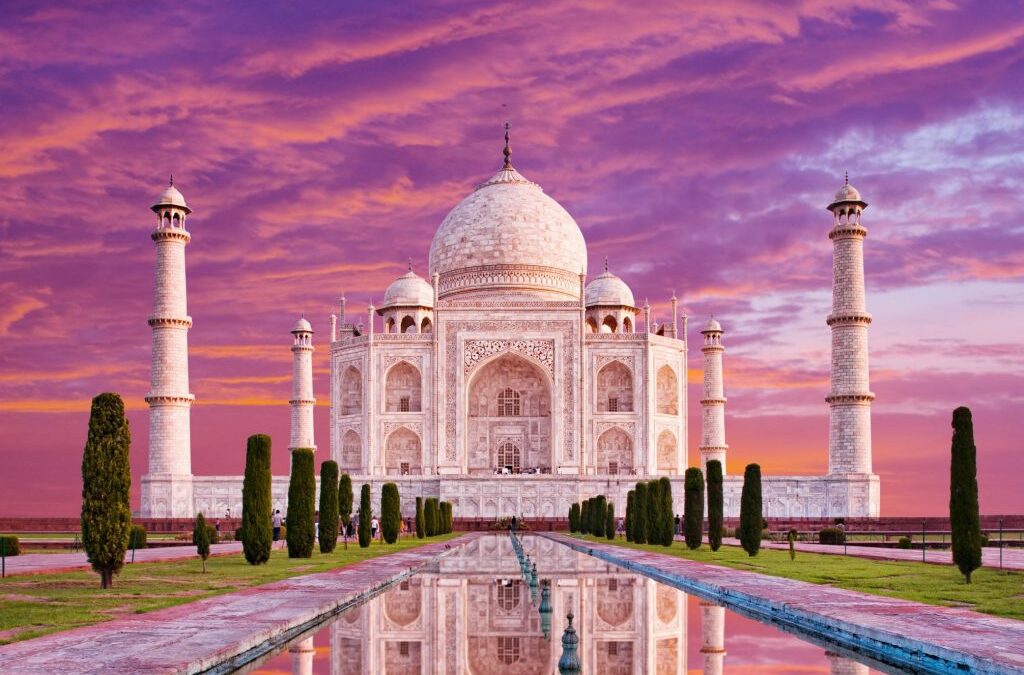The Taj Mahal, an eternal symbol of love and one of the Seven Wonders of the World, stands majestically on the banks of the Yamuna River in Agra, India. Built by Emperor Shah Jahan in memory of his beloved wife Mumtaz Mahal, this marble mausoleum attracts millions of visitors every year. Whether you’re a history enthusiast, a romantic soul, or an architecture lover, a visit to the Taj Mahal is an experience of a lifetime. This guide will ensure your Taj Mahal tour is both enriching and memorable.
History and Significance
Its intricate carvings, symmetry, and the way it reflects hues of light at different times of the day make it a marvel beyond words.
Best Time to Visit
The best time to visit the Taj Mahal is during the cooler months from October to March, avoiding the scorching heat of Indian summers. Early mornings and evenings provide the most enchanting views, as the soft light enhances the marble’s beauty. Full moon nights are especially magical, offering a serene and glowing perspective of this iconic monument.
How to Reach the Taj Mahal
By Air
The nearest airport is Agra Airport (Kheria), approximately 13 km from the Taj Mahal. For international travelers, Indira Gandhi International Airport in Delhi is a better option, about 230 km away.
By Train
Agra is well-connected by rail. Agra Cantt Railway Station is the main station, located 6 km from the Taj Mahal. Opt for the Gatimaan or Shatabdi Express for a comfortable and quick journey from Delhi.
By Road
Agra is easily accessible via the Yamuna Expressway, making it a popular choice for road trips from Delhi and nearby cities.
Entry Details
- Entry Fee:
- Foreign tourists: ₹1300
- SAARC/BIMSTEC nationals: ₹740
- Indian citizens: ₹50
Key Highlights of the Taj Mahal
1. The Main Mausoleum
The central structure, built entirely of white marble, houses the cenotaphs of Mumtaz Mahal and Shah Jahan. Admire the intricate inlay work, floral motifs, and Arabic calligraphy inscribed on the walls.
2. The Charbagh Garden
This beautifully landscaped garden, divided into four parts by walkways and water channels, represents paradise as described in Islamic texts. The symmetry and tranquility here make it a perfect spot for photos.
3. The Reflecting Pool
The iconic photographs of the Taj Mahal often feature its reflection in the pool in front of the mausoleum. Arrive early to capture this view without the crowds.
4. The Minarets
The four slender minarets surrounding the Taj Mahal enhance its elegance.
5. The Mosque and Guesthouse
Located on either side of the Taj Mahal, the mosque and guesthouse add to the architectural harmony.
Read more: Most Beautiful Places in the World
Nearby Attractions
1. Agra Fort
A UNESCO World Heritage Site, this red sandstone fort is just 2.5 km from the Taj Mahal. Explore its palaces, mosques, and halls that narrate tales of Mughal grandeur.
2. Mehtab Bagh
It’s an excellent spot for photography enthusiasts.
3. Fatehpur Sikri
A historic city located about 40 km from Agra, Fatehpur Sikri boasts architectural wonders like Buland Darwaza and Jama Masjid.
Tips for an Unforgettable Taj Mahal Tour
- Plan Early: Arrive early to avoid crowds and experience the serene beauty of the Taj Mahal.
- Dress Comfortably: Wear modest clothing and comfortable footwear.
- Engage a Guide: A knowledgeable guide can enrich your visit with fascinating stories and historical insights.
- Respect the Monument: Avoid touching the walls or defacing the property. Follow all guidelines issued by the authorities.
- Full Moon Visit: Book tickets in advance for a moonlit tour, which offers a unique and mystical experience.
Conclusion
The Taj Mahal is not just a monument; it is an emotion, a timeless ode to love, and an architectural masterpiece that continues to captivate hearts worldwide. Plan your visit today and witness one of humanity’s greatest creations.
FAQs About Visiting the Taj Mahal
1. What is the best time to visit the Taj Mahal?
The best time to visit is during the cooler months from October to March. Early mornings, evenings, and full moon nights offer the most breathtaking views.
2. Is the Taj Mahal open every day?
No, the Taj Mahal is closed on Fridays for prayers. On other days, it is open from sunrise to sunset.
3. What is the entry fee for the Taj Mahal?
- Foreign tourists: ₹1300
- SAARC/BIMSTEC nationals: ₹740
- Indian citizens: ₹50
4. Can I take photographs inside the Taj Mahal?
Yes, photography is allowed outside and within the complex. However, tripods and photography inside the main mausoleum are prohibited.
5. Is there a dress code to visit the Taj Mahal?
There is no strict dress code, but it is recommended to dress modestly as the Taj Mahal is a cultural and religious site.
6. How do I book tickets for the Taj Mahal?
You can book tickets online via the official website or purchase them at the ticket counters near the site.
7. What are the visiting hours for the Taj Mahal?
The Taj Mahal is open from sunrise to sunset. Special night visits are available on full moon nights, two days before and after the full moon.
8. What items are prohibited at the Taj Mahal?
Large bags, food items, smoking materials, tripods, and sharp objects are not allowed. Carry only essential items like your wallet, water bottle, and phone.
9. How can I reach the Taj Mahal from Delhi?
- By road: The Yamuna Expressway connects Delhi and Agra.
- By train: Fast trains like Gatimaan Express and Shatabdi Express operate between Delhi and Agra.
- By air: Agra Airport is about 13 km from the Taj Mahal.
10. Is it possible to visit the Taj Mahal and Agra Fort on the same day?
Yes, both the Taj Mahal and Agra Fort are close to each other, and a day is sufficient to explore both sites.
